Physical Address
304 North Cardinal St.
Dorchester Center, MA 02124
On completion of this chapter, you should be able to:
Describe the role of the sonographer and the career path
Know the historical developments in medical ultrasound
List the basic principles and terminology of medical ultrasound
Identify the transducers necessary for specific ultrasound applications
Explain the multiple display modes on ultrasound instrumentation
State the Doppler effect
The primary purpose of this chapter is to introduce the sonographer to the fascinating field of diagnostic medical ultrasound. Historians will tell us that we cannot know where we are going until we know where we have been. Therefore a brief background into the historical development of ultrasound is presented to enable the sonographer to understand the progress that has been made with technology in the medical application of ultrasound. It is important for sonographers to understand their role in the health care field and to have a global concept of anatomic reconstruction. An introduction into the terminology of the basic principles of ultrasound is critical for the student to understand how and why an anatomic image appears as it does on the ultrasound monitor.
The words diagnostic medical ultrasound, ultrasound , and ultrasonography have all been used to describe the instrumentation used in ultrasound. Sonography is the term used to describe a specialized imaging technique to visualize soft tissue structures in the body. The term echocardiography , or simple “echo,” refers to an ultrasound examination of only the cardiac structures.
A sonographer is a member of the allied health profession who has received specialized education in diagnostic medical sonography and has successfully completed the national boards given by the American Registry of Diagnostic Medical Sonography. A sonologist is a physician who has received specialized training in ultrasound and has successfully completed the national boards granted by their respective specialty (e.g., radiology, cardiology, obstetrics).
The field of diagnostic medical ultrasound has grown to become a well-respected and valuable addition to diagnostic imaging by providing pertinent clinical information to the physician and to the patient. The applications of ultrasound are extensive; they include, but are not limited to, the following areas:
General ultrasound (abdominal, renal, retroperitoneal, chest)
Superficial ultrasound (breast, thyroid, scrotum)
Neonatal and pediatric ultrasound (abdomen, renal, hips, brain, spine)
Echocardiography (adult, pediatric, neonatal, fetal)
Interventional and therapeutic guided ultrasound
Obstetric and gynecologic ultrasound
Intraoperative ultrasound
Musculoskeletal ultrasound
Ophthalmologic ultrasound
Point of care ultrasound
Extensive research has verified the safety of ultrasound as a diagnostic procedure. No harmful effects of ultrasound have been demonstrated at power levels used for diagnostic studies when performed by qualified and nationally certified sonographers, under the direction of qualified and board-certified sonologists, using appropriate equipment and techniques.
Diagnostic ultrasound has developed into a valuable imaging technique for many reasons. First is the lack of ionizing radiation for the ultrasound procedure compared with the various other imaging modalities such as computed tomography (CT) or nuclear medicine. The second reason is the portability of the ultrasound equipment. Even the high-end equipment may be moved into the intensive care unit, emergency department, operating room, cardiac catheterization lab, or physician’s office. The low-end systems are now so portable they can fit into the physician’s lab coat to be used at the bedside as an initial quick look evaluation of the patient physical examination.
Ultrasound is unique in other ways as well. The ultrasound image is presented in a real-time cine clip format, which makes it possible to see the image transition from one cardiac structure to another, or from one organ system to another. The flexible multiplanar imaging capability allows the sonographer to “follow” the path of a tortuous vessel, a moving cardiac structure, or a moving fetus to capture the necessary images. Moreover, Doppler techniques allow the qualitative and quantitative evaluation of blood flow hemodynamics within a vessel. Finally, the cost analysis of an ultrasound system is superior compared with other imaging diagnostic systems.
Currently nearly all hospitals and medical clinics have access to some form of ultrasound instrumentation to provide the clinician with an inside look at the soft tissue structures within the body. Ultrasound manufacturers continue their research to improve image acquisition, develop efficient transducer functionality and design, and create software to improve computer assessment of the acquired information. Two-dimensional (2D) ultrasound information can be recreated in a 3D or 4D (real-time) format to provide an “en face” surface rendering of the specific area. Color Doppler, harmonics, tissue characterization, elastography, strain, and spectral analysis have greatly expanded the utility of ultrasound imaging. The development of specialized contrast agents for use with ultrasound has enabled the clinicians to make specific diagnoses with greater precision.
To obtain even more information from the ultrasound image, various medical centers and manufacturers continue their work towards the development of effective contrast agents that may be ingested or administered intravenously into the bloodstream to facilitate the detection and diagnosis of specific pathologies. Early attempts at producing a contrast effect with ultrasound imaging involved administration of aerated saline or carbon dioxide. Currently research is focused on the development of gas microspheres, which are injected into the patient to provide visual contrast during the ultrasound study. Specific applications of ultrasound contrast are found in Chapter 17 .
The sonographer is an allied health professional who has received specific training in diagnostic medical sonography (general applications) or cardiovascular technology (cardiac and vascular applications). The sonographer performs ultrasound procedures and gathers diagnostic data under the direct or indirect supervision of a physician. Sonographers are known as “image makers” who have the ability to create images of soft tissue structures and organs inside the body, such as the liver, pancreas, biliary system, kidneys, heart, vascular system, muscular skeletal system, uterus, and fetus. In addition, sonographers can record hemodynamic information with velocity measurements through the use of color Doppler and spectral analysis to determine if a vessel or cardiac valve is patent (open) or restricted.
Sonographers work directly with physicians and patients as a team member in a medical facility. They also interact with nurses and other medical staff as part of the health care team. The sonographer must be able to review the patient’s records to assess clinical history and clinical symptoms, interpret laboratory values, and review other pertinent diagnostic examinations. The sonographer is required to understand and operate complex ultrasound instrumentation using the basic principles of ultrasound physics.
To produce the highest-quality sonographic image for interpretation, the sonographer must possess an in-depth understanding of anatomy and pathophysiology and be able to evaluate a patient’s problem specific to the examination ordered. Sonographers use their knowledge and skills to provide physicians with clinical information such as the rapid FAST scan evaluation of a trauma victim’s injury, visualization of detailed fetal anatomy, and measurement and evaluation of fetal growth and progress or even to evaluate the patient for cardiac abnormalities or injury. In addition to technical expertise and knowledge of anatomy and pathophysiology, several other qualities contribute to the sonographer’s success ( Box 1.1 ).
The sonographer must possess the following qualities and talents:
Intellectual curiosity to keep abreast of developments in the field
Perseverance to obtain high-quality images and the ability to differentiate an artifact from structural anatomy
Ability to conceptualize two-dimensional (2D) images into a 3D format; ability to reconstruct a 2D image into a 3D format to product an “en face” image
Quick and analytical mind to continually analyze image quality while keeping the clinical situation in mind
Technical aptitude to produce diagnostic-quality images
Good physical health because continuous scanning may cause strain on back, shoulder, or arm. Equipment is mobile; thus the sonographer must be able to manipulate equipment weighing greater than 250 pounds. Doppler is audible; thus sonographers must have adequate hearing to interpolate the returning Doppler audible sound
Independence and initiative to analyze the patient, the history, and the clinical findings and tailor the examination to answer the clinical question
Emotional stability to deal with patients in times of crisis; this means the ability to understand the patient’s concerns without losing objectivity
Communication skills for interactions with peers, clinicians, and patients; this includes the ability to clearly communicate ultrasound findings to physicians and the ability not to disclose or speculate on findings to the patient during the examination
Dedication because a willingness to go beyond the “call of duty” is often required of the sonographer
What makes the sonographer distinct from the other health care professionals? The sonographer:
Reviews the clinical chart and speaks directly with patients to identify symptoms that relate directly to the ultrasound examination.
Explains the procedure to the patient and performs the examination using the protocol established by the department.
Analyses each image and correlates the information with patient information.
Uses independent judgment in recognizing the need to make adjustments with the sonographic protocol to answer the clinical question.
Reviews the previous sonograms and provides an oral or written summary of the technical findings to the physician for the medical diagnosis.
Alerts the physician if critical findings or new changes are found on the sonographic examination.
Sonographers with specialized education in ultrasound obtained from a nationally accredited diagnostic medical sonography or cardiovascular technology program have demonstrated their ability to analyze the clinical situation and to produce high-quality sonographic images, thereby earning the respect of other allied health professionals and clinicians. Every day, sonographers are faced with varied human interactions and opportunities to solve problems. These experiences give sonographers an outlet for their creativity by requiring them to come up with innovative ways to meet the challenges of performing quality sonographic examinations on difficult patients. Sonographers must have the creative ability to alter their normal protocol as difficult situations arise (i.e., trauma patient, immobile patient, postoperative surgical patient with multiple bandages). New applications in ultrasound and improvements in instrumentation create a continual challenge for the sonographer. Flexible schedules and variety in examinations and equipment, not to mention patient personalities, make each day interesting and unique. Certified sonographers find that employment opportunities are abundant, schedule flexibility is high, and salaries are attractive.
Some sonographers find their position to be stressful and demanding, with the constant changes in medical care and decreased staffing causing increased workloads. Hours of continual scanning may lead to tendinitis, arm and shoulder pain, and back strain. ( Chapter 3 focuses on ergonomics and musculoskeletal issues in sonography.)
Sonographers may become frustrated when dealing with terminally ill patients, which can lead to fatigue and depression.
The field of sonography continues to expand. The demand for certified sonographers exceeds the supply nationwide. Sonographers may find employment in the traditional setting of a hospital or medical clinic. Staffing positions within the hospital or medical setting may include the following: Director of Imaging, Technical Director, Manager, Supervisor, Chief Sonographer, Sonographer Educator, Clinical S taff Sonographer, Research Sonographer, or Clinical Instructor. Clinical research opportunities may be found in the major medical centers throughout the country. Sonographers with advanced degrees (e.g., BS, MS, or PhD) may serve as faculty in diagnostic medical sonography programs as Program Director, Department Head, or Dean of Allied Health. Many sonographers have entered the commercial world as Clinical Application Specialists or Director of Education/Continuing Education Director, marketing specialist, product design/engineering, sales, service, or quality control. Other sonographers have become independent business partners in medicine by offering mobile ultrasound services to smaller community hospitals.
Specific organizations are devoted to developing standards and guidelines for ultrasound:
American Institute of Ultrasound in Medicine (AIUM), www.aium.org . This organization represents all facets of ultrasound to include physicians, sonographers, biomedical engineers, scientists, and commercial researchers.
American Society of Echocardiography (ASE), www.asecho.org . This very active organization represents physicians, sonographers, and scientists involved with cardiovascular applications of sonography.
Society of Diagnostic Medical Sonography (SDMS), www.sdms.org . This is the principal organization for more than 25,000 sonographers. The website contains information regarding the SDMS position statement on the code of ethics for the profession of diagnostic medical ultrasound; the nondiagnostic use of ultrasound, the scope of practice for the diagnostic ultrasound professional, and diagnostic ultrasound clinical practice standards.
Society for Vascular Ultrasound (SVU), www.svunet.org . This is the principal organization representing physicians, sonographers, and scientists in vascular sonography.
The National Certification Examination for Ultrasound is provided by the American Registry for Diagnostic Medical Sonography (ARDMS), www.ardms.org . This is the primary organization offering international credentials for sonographers once their training has been completed.
The national review boards for educational programs in sonography are provided by two groups:
Joint Review Committee on Education in Diagnostic Medical Sonography (JRC-DMS) (includes general ultrasound, echocardiography, and vascular technology), www.jrcdms.org .
Joint Review Committee on Education in Cardiovascular Technology (JRC-CVT) (includes noninvasive cardiology (echocardiography), invasive cardiology (cardiac catheterization), and vascular technology), www.jrccvt.org .
A complete history of sound theory and the development of medical ultrasound is beyond the scope of this textbook. The following is a brief overview designed to provide readers a sense of the extensive history and exciting developments in this area of study. For a more detailed outline of historical data, the reader is referred to Dr. Joseph Woo’s excellent article “A Short History of the Development of Ultrasound in Obstetrics and Gynecology” and other resources listed in the Selected Bibliography at the end of this chapter.
The story of acoustics began with the Greek philosopher Pythagoras (6th century bc ), whose experiments on the properties of vibrating strings led to the invention of the sonometer, an instrument used to study musical sounds. Several hundred years later, in 1500 ad , Leonardo da Vinci (1452–1519) discovered that sound traveled in waves and discovered that the angle of reflection is equal to the angle of incidence . Galileo Galilei (1564–1642) is said to have started modern studies of acoustics by elevating the study of vibrations to scientific standards. In 1638, he demonstrated that the frequency of sound waves determined the pitch. Sir Isaac Newton (1643–1727) studied the speed of sound in air and provided the first analytic determination of the speed of sound. Robert Boyle (1627–1691), an Irish natural philosopher, chemist, physicist, and inventor, demonstrated the physical characteristics of air, showing that it is necessary in combustion, respiration, and sound transmission. Lazzaro Spallanzani (1729–1799), an Italian biologist and physiologist, essentially discovered echolocation. Spallanzani is famous for extensive experiments on bat navigation, from which he concluded that bats use sound and their ears for navigation in total darkness. Augustin Fresnel (1788–1827) was a French physicist who contributed significantly to the establishment of the theory of wave optics, forming the theory of wave diffraction named after him. Sir Francis Galton (1822–1911) was an English Victorian scholar, explorer, and inventor. One of his numerous inventions was the Galton whistle used for testing differential hearing ability. This is an ultrasonic whistle, also known as a dog whistle or a silent whistle. Christian Johann Doppler (1803–1853) was an Austrian mathematician and physicist. He is most famous for what is now called the “Doppler effect,” which is the apparent change in frequency and wavelength of a wave as perceived by an observer moving relative to the wave’s source. In 1880, Paul-Jacques Curie (1856–1941) and his brother Pierre Curie (1859–1906) discovered piezoelectricity , whereby physical pressure applied to a crystal resulted in the creation of an electric potential. John William Strutt (Lord Rayleigh) (1842–1919) wrote The Theory of Sound . The first volume, on the mechanics of a vibrating medium which produces sound, was published in 1877; the second volume on acoustic wave propagation was published the following year. Paul Langevin (1872–1946) was a French physicist and is noted for his work on paramagnetism and diamagnetism. He devised the modern interpretation of this phenomenon in terms of spins of electrons within atoms. His most famous work was on the use of ultrasound using Pierre and Jacques Curie’s piezoelectric effect. During World War I, he began working on the use of these sounds to detect submarines through echolocation.
Sonar is an acronym for sound navigation and ranging . Sonar is a technique that uses sound propagation, usually underwater, to navigate, communicate with, or detect other vessels. Sonar may be used as a means of acoustic location and measurement of the echo characteristics of “targets” in the water. The term sonar is also used for the equipment necessary to generate and receive the sound. The acoustic frequencies used in sonar systems vary from very low (infrasonic) to extremely high (ultrasonic). World War II brought sonar equipment to the forefront of military defense, and medical ultrasound was influenced by the advances in sonar instrumentation.
In the 1940s, Dr. Karl Dussik (1908–1968) made one of the earliest applications of ultrasound to medical diagnosis when he used two transducers positioned on opposite sides of the head to measure ultrasound transmission profiles ( Fig. 1.1 ). He discovered that tumors and other intracranial lesions could be detected by this technique. Dr. William Fry , an electrical engineer whose primary research was in the field of ultrasound, is credited with being the first to introduce the use of computers in diagnostic ultrasound. Around this same time, he and Dr. Russell Meyers performed craniotomies and used ultrasound to destroy parts of the basal ganglia in patients with parkinsonism.
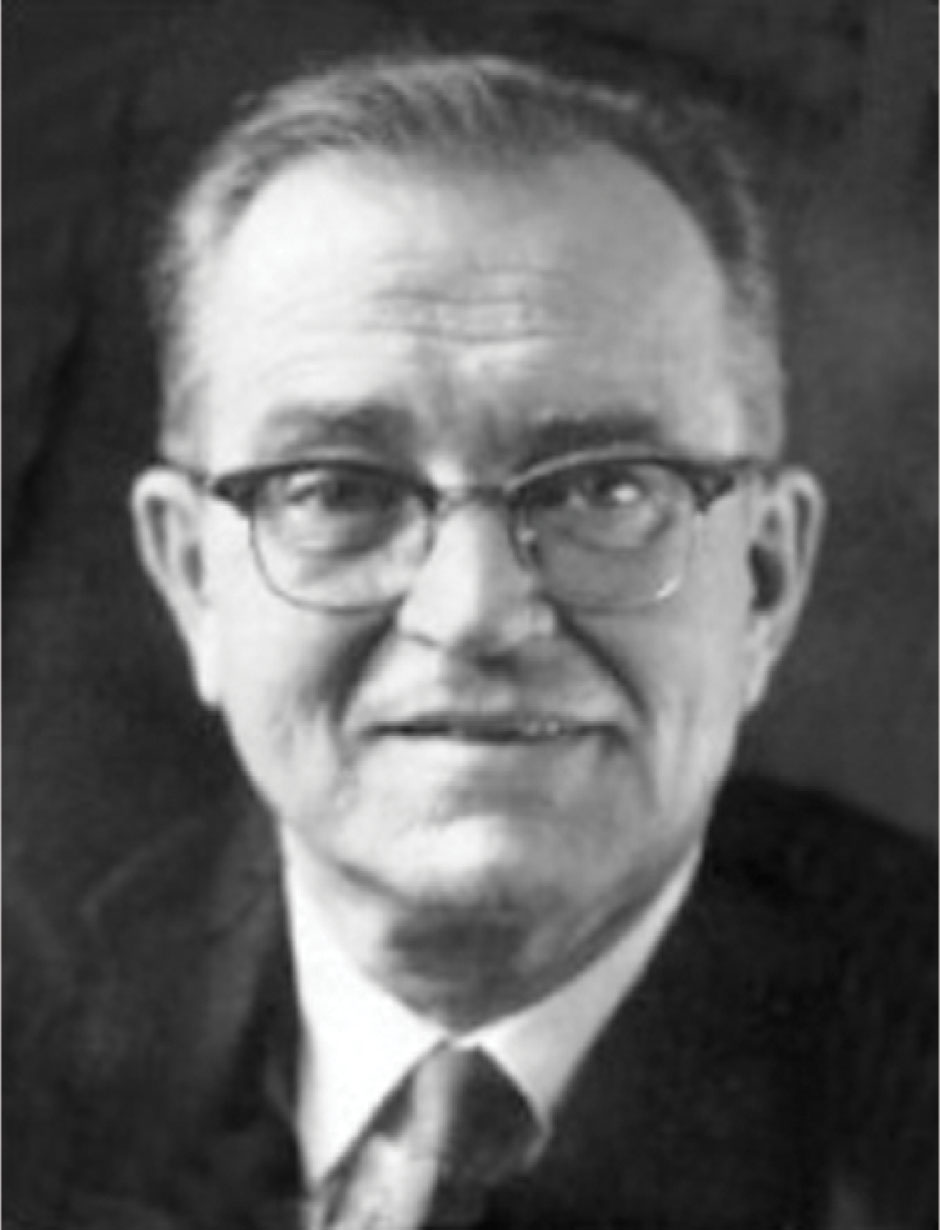
Between 1948 and 1950, three investigators, Drs. Douglass Howry , a radiologist, John Wild , a clinician interested in tissue characterization, and George Ludwig , who was interested in reflections from gallstones, each demonstrated independently that when ultrasound waves generated by a piezoelectric crystal transducer are transmitted into the body, ultrasound waves of different acoustic impedances are returned to the transducer.
One of the pioneers in the clinical investigation and development of ultrasound was Dr. Joseph Holmes (1902–1982). A nephrologist by training, Dr. Holmes’ initial interest in ultrasound involved its ability to detect bubbles in hemodialysis tubing. Holmes began work in ultrasound at the University of Colorado Medical Center in 1950, in collaboration with a group headed by Douglass Howry . In 1951, supported by Joseph H. Holmes, Douglass Howry, along with William Roderic Bliss and Gerald J. Posakony , both engineers, produced the “immersion tank ultrasound system,” the first 2D B-mode (or plan position indicator [PPI] mode) linear compound scanner ( Fig. 1.2 ). 2D cross-sectional images, published in 1952, demonstrated that interpretable 2D images of internal organ structures and pathologies could be obtained with ultrasound. The Pan Scanner , created by the Holmes, Howry, Posakony, and Richard Cushman team in 1957, was a landmark invention in the history of B-mode ultrasonography. With the Pan Scanner, the patient sat on a modified dental chair strapped against a plastic window of a semicircular pan filled with saline solution while the transducer rotated through the solution in a semicircular arc ( Fig. 1.3 ).
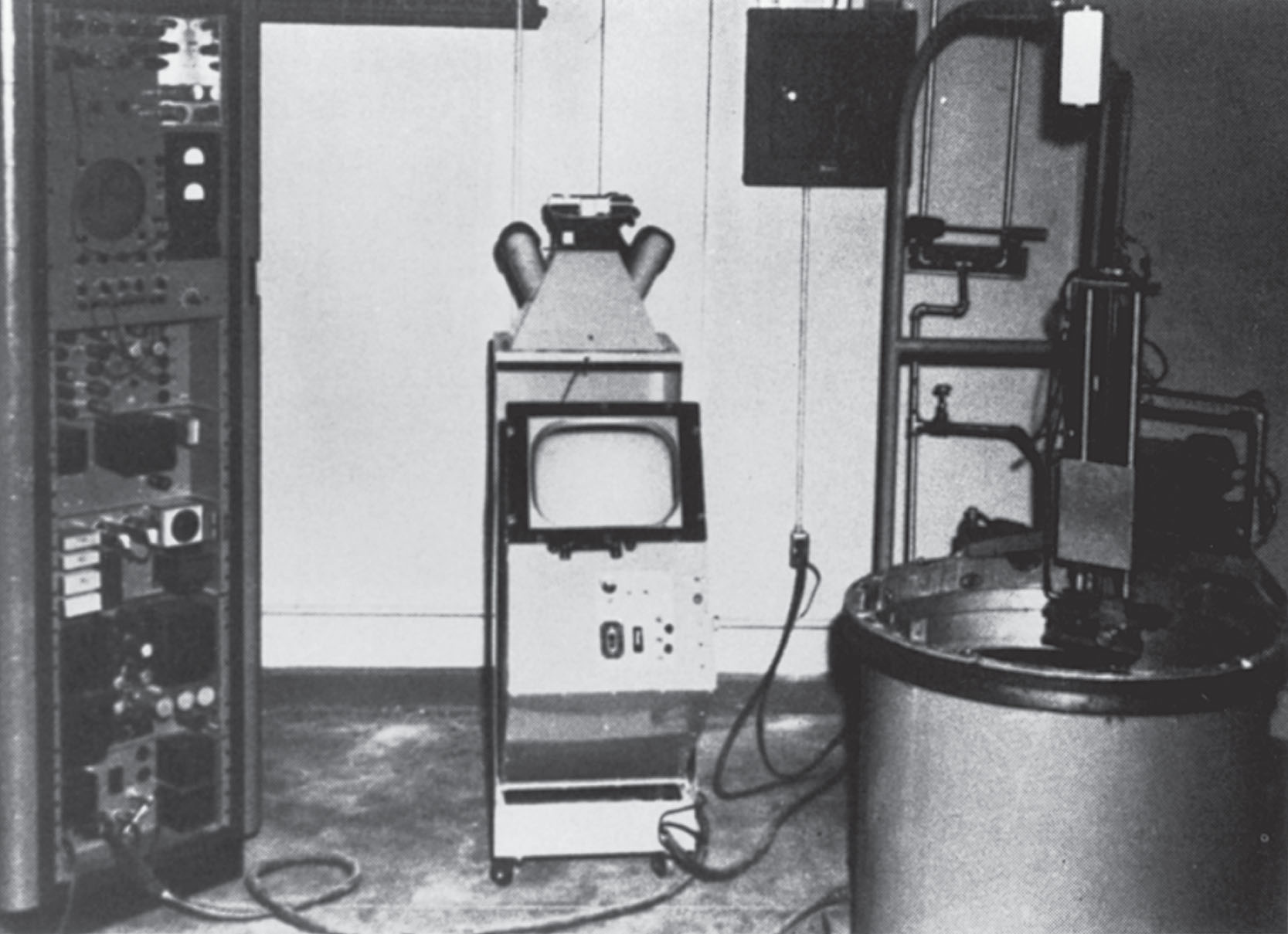
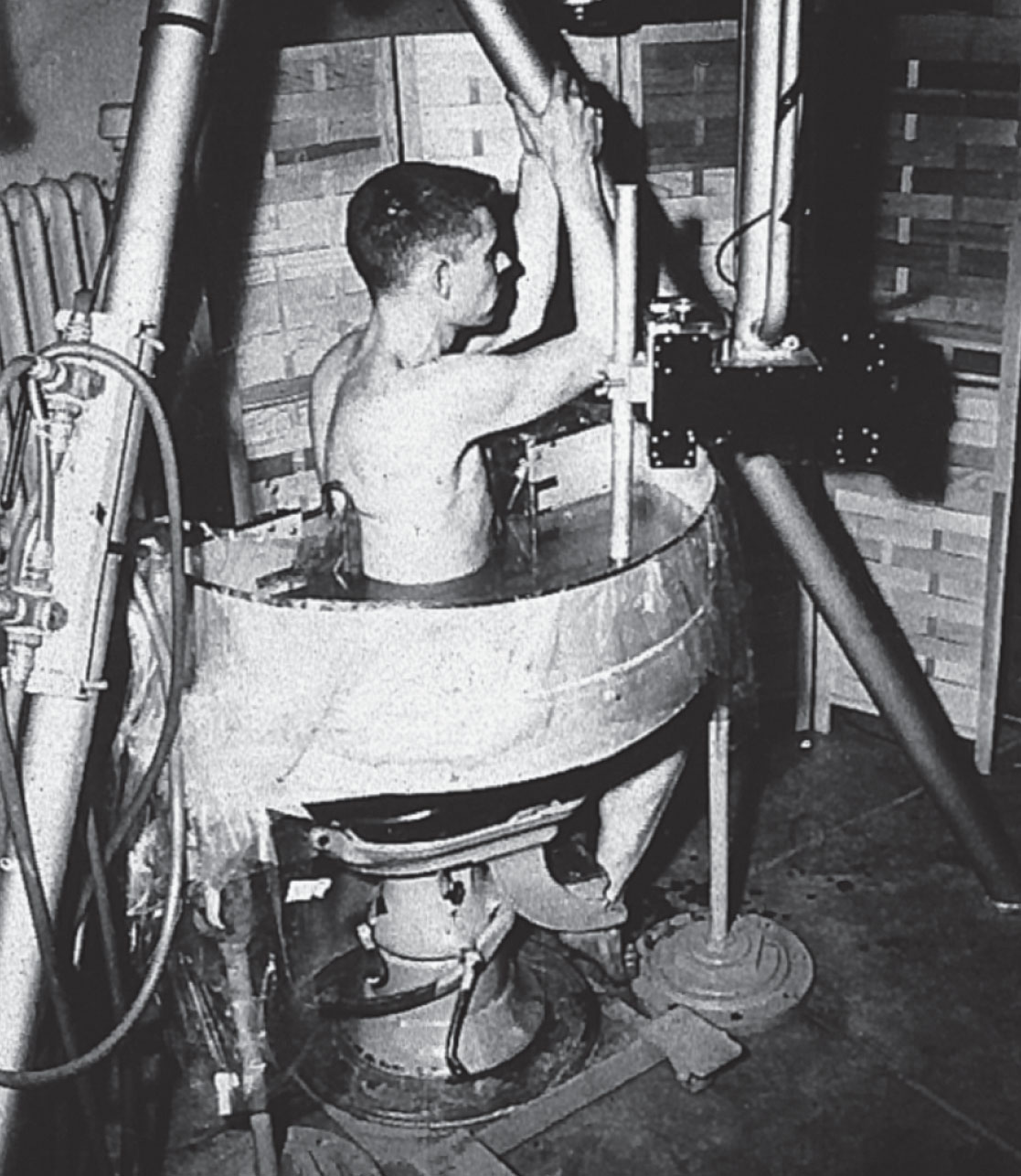
In 1954, echocardiographic ultrasound applications were developed in Sweden by Drs. Hellmuth Hertz and Inge Edler , who first described the M-mode (motion) display ( Fig. 1.4 ).
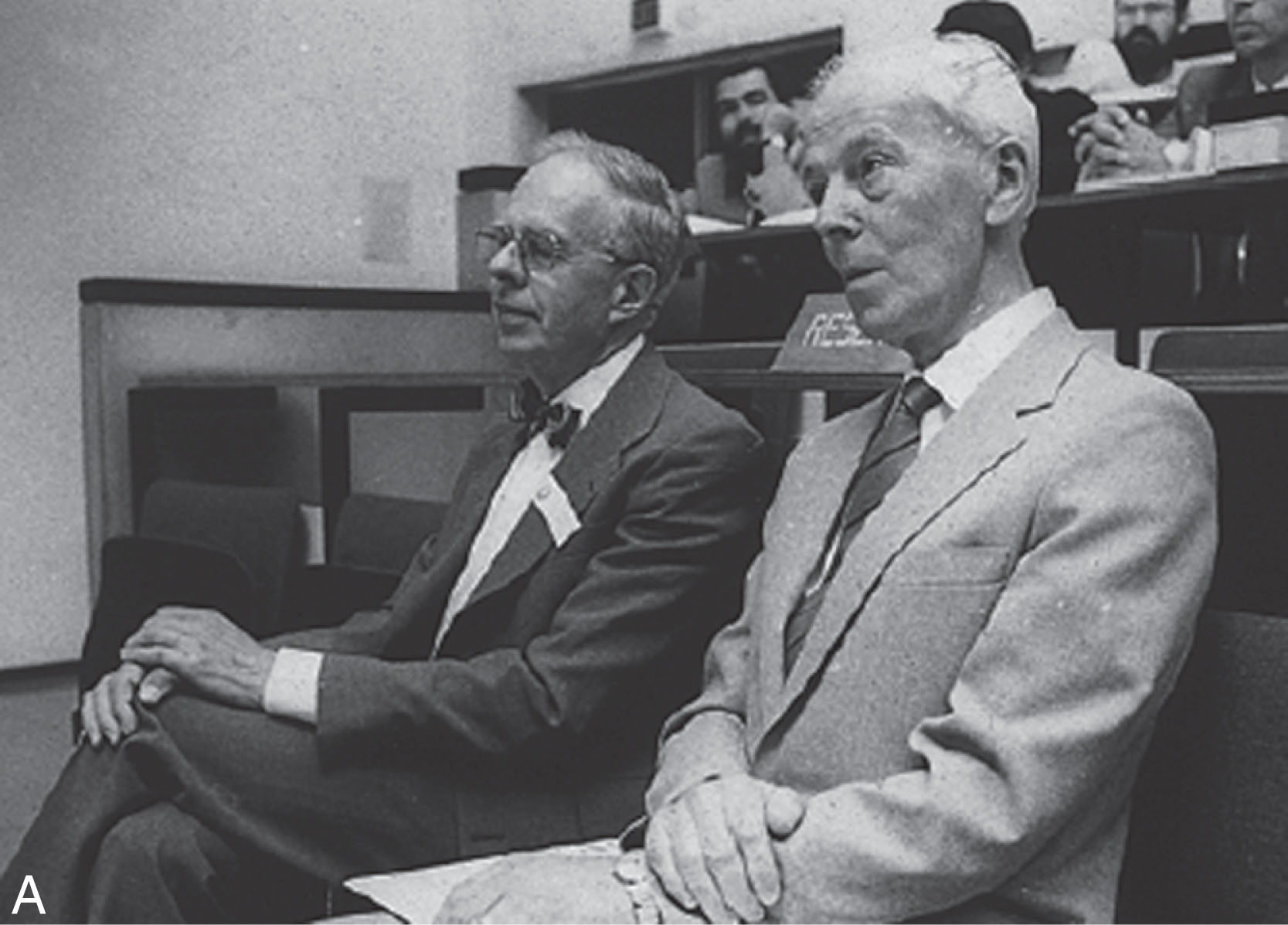
An early obstetric contact compound scanner was built by Tom Brown and Dr. Ian Donald (1910–1987) in Scotland in 1957. Dr. Donald went on to discover many fascinating image patterns in the obstetric patient; his work is still referred to today. Meanwhile, in the early 1960s in Philadelphia, Dr. J Stauffer Lehman designed a real-time water path obstetric ultrasound system ( Fig. 1.5A ).
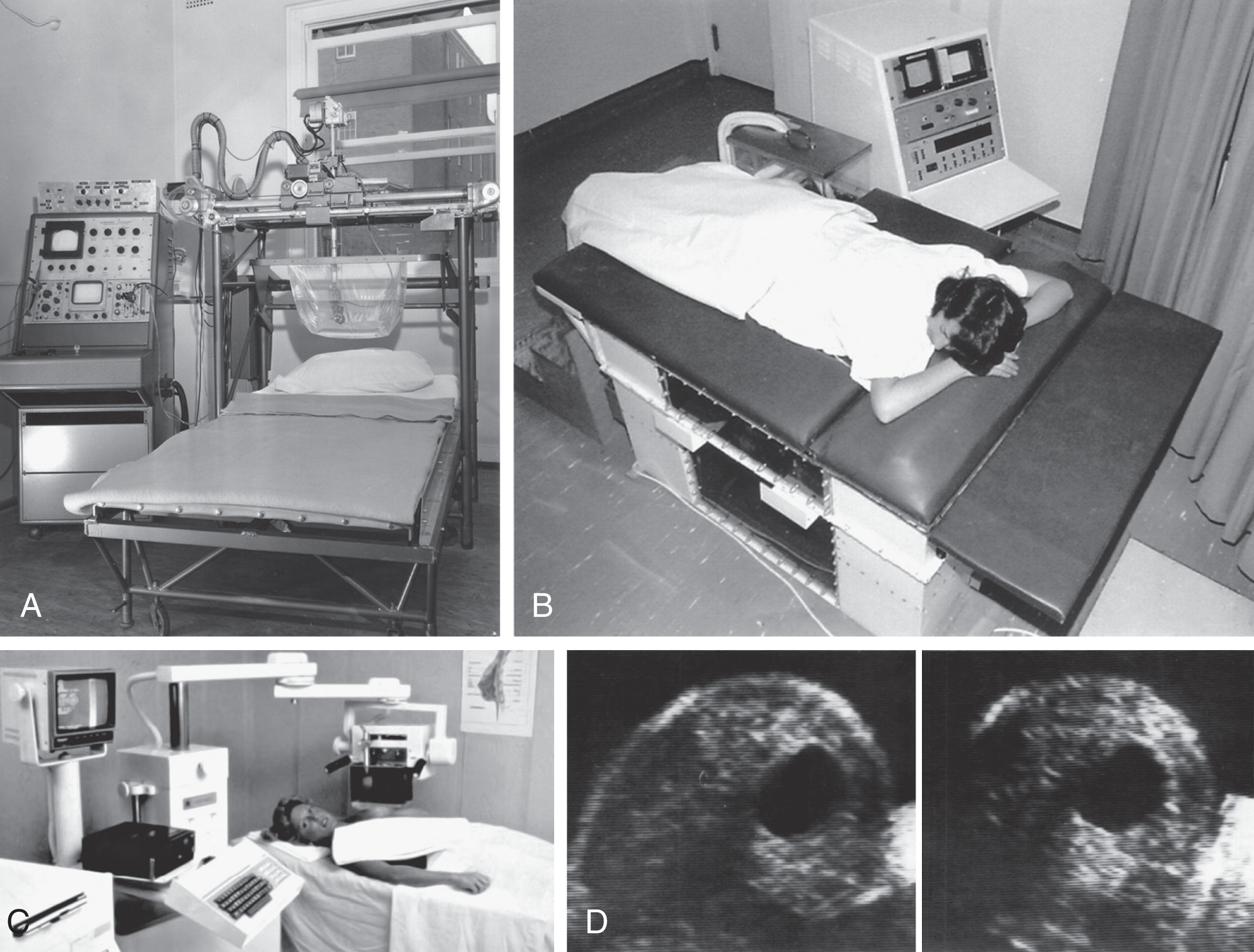
In 1959 the Ultrasonic Institute was formed at the National Acoustic Laboratory in Sydney, Australia. George Kossoff and his team, including Dr. William Garrett and David Robinson , developed diagnostic B-scanners with the use of a water bath to improve resolution of the image ( Figs. 1.5 and 1.6 ). This group was also responsible for introducing gray-scale imaging in 1972. Kossoff and his colleagues were pioneers in the development of large-aperture, multitransducer technology in which the transducers were automatically programmed to operate independently or as a whole to provide high-quality images without operator intervention, as was required with the contact static scanner that had been developed in 1962 at the University of Colorado.
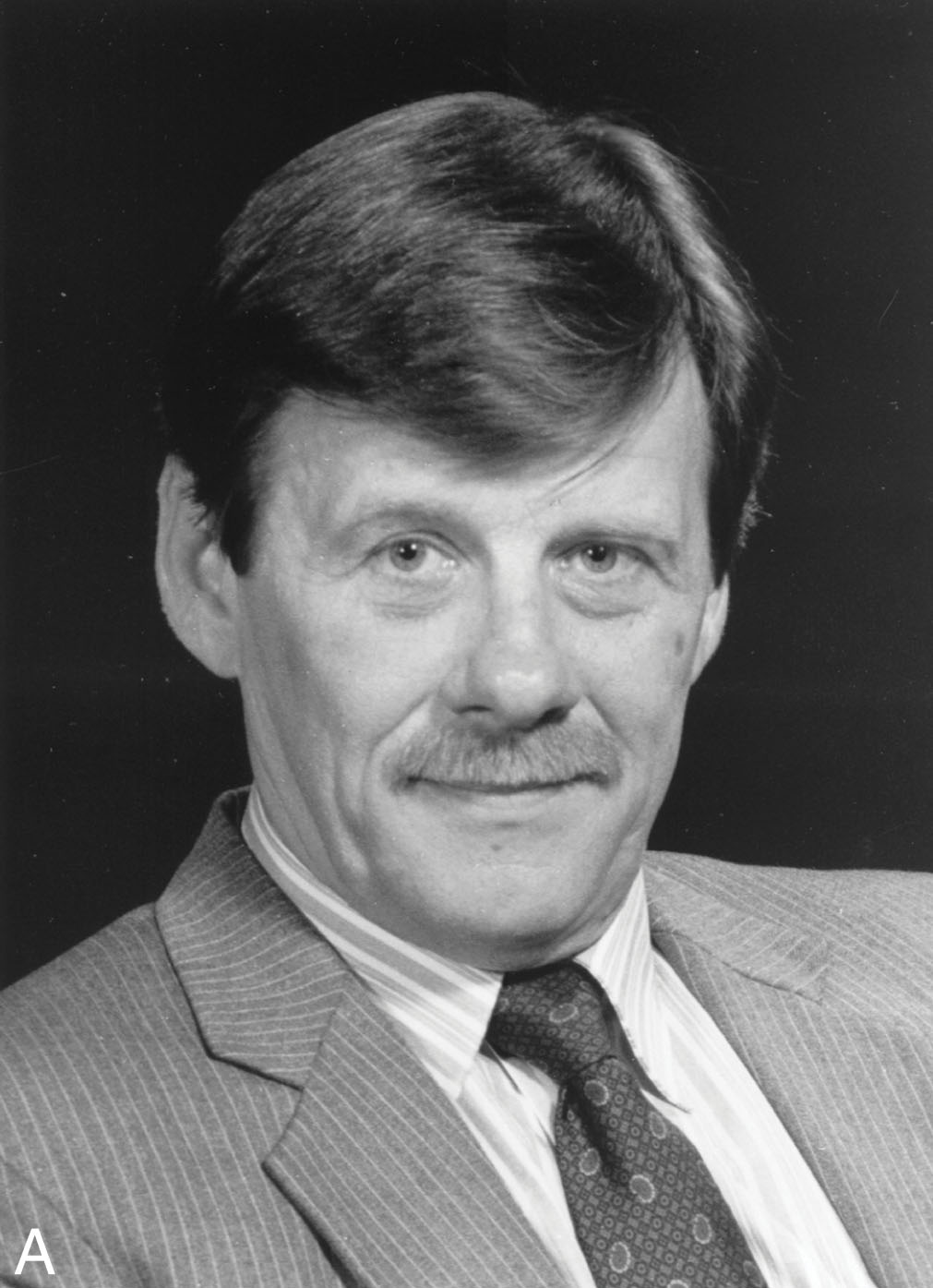
The advent of real-time scanners changed the face of ultrasound scanning. The first real-time scanner (initially known as a fast B-scanner) was developed by Walter Krause and Richard Soldner . It was manufactured as the Vidoscan by Siemens Medical Systems of Germany in 1965. The Vidoscan used three rotating transducers housed in front of a parabolic mirror in a water coupling system and produced 15 images per second. The image was made up of 120 lines with basic gray scale. The use of fixed-focus, large-face transducers produced a narrow beam to ensure good resolution and a good image. Fetal life and motions could be demonstrated clearly. In 1973 James Griffith and Walter Henry at the National Institutes of Health produced a mechanical oscillating real-time scanning device that could produce clear 30-degree sector real-time cardiac images with good resolution. The phased-array scanning mechanism was first described by Jan Somer at the University of Limberg in the Netherlands and was in use from 1968, several years before the appearance of linear-array systems.
Medical applications of ultrasonic Doppler techniques were first implemented by Shigeo Satomura and Yasuhara Nimura at the Institute of Scientific and Industrial Research in Osaka, Japan, in 1955 for the study of cardiac valve motion and pulsations of peripheral blood vessels. This team pioneered transcutaneous Doppler flow measurements in 1959. In 1966 Kato and T. Izumi pioneered the directional flowmeter using the local oscillation method whereby flow directions were detected and displayed. This was a breakthrough in Doppler instrumentation because reverse flow in blood vessels could now be documented. In the United States, Robert Rushmer and his team did groundbreaking work in Doppler instrumentation, beginning in 1958. They pioneered transcutaneous continuous wave (CW) flow measurements and spectral analysis in 1963. Donald Baker , a member of Rushmer’s team, introduced a pulsed-Doppler system in 1970 ( Fig. 1.7 ). In 1974 Baker, along with John Reid , Frank Barber , and others, developed the first duplex pulsed-Doppler scanner, which allowed 2D scale imaging to be used to guide placement of the ultrasound beam for Doppler signal acquisition. In 1985 a work entitled “Real-Time Two-Dimensional Blood Flow Imaging Using an Autocorrelation Technique” by Chihiro Kasai, Koroku Namekawa , and Ryozo Omoto was published in English. The autocorrelation technique described in this publication could be applied to estimating blood velocity and turbulence in color flow imaging. The autocorrelation technique is a method for estimating the dominating frequency in a complex signal, as well as its variance. The algorithm is both computationally faster and significantly more accurate compared with the Fourier transform because the resolution is not limited by the number of samples used. This provided the rapid means of frequency estimation to be performed in real time that is still used currently.
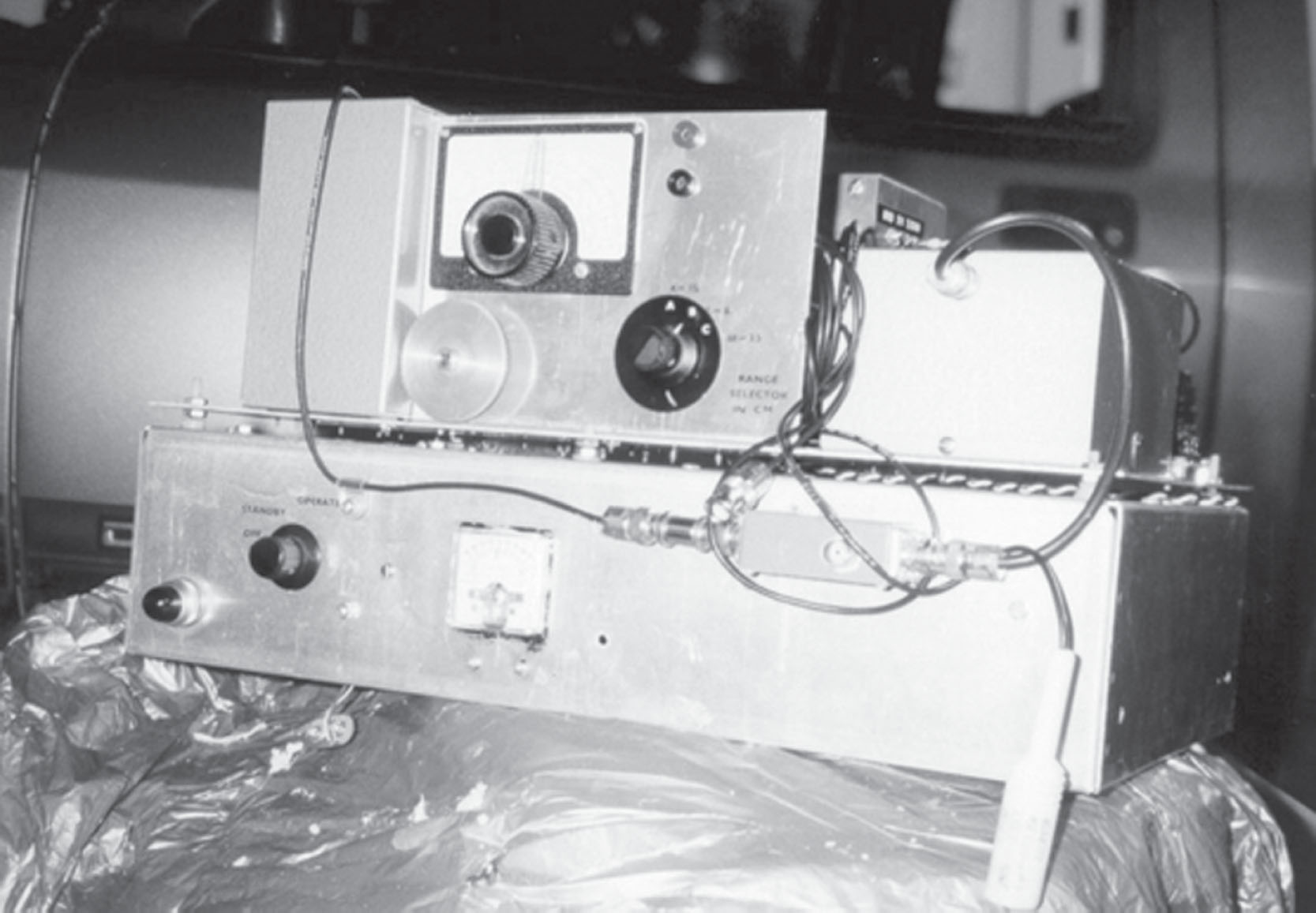
In 1987 The Center for Emerging Cardiovascular Tech-nologies at Duke University started a project to develop a real-time volumetric scanner for cardiac imaging. In 1991 they produced a matrix array scanner that could image cardiac structures in real time and in 3D. By the second half of the 1990s, many other centers throughout the world were working on laboratory and clinical research into 3D ultrasound (3DU). Currently, 3DU has developed into a clinically effective diagnostic imaging technique.
To produce high-quality images that are free of artifacts, the sonographer must have a firm understanding of the basic principles of ultrasound. This section introduces the basic principles of acoustics, measurement units, instrumentation, real-time sonography, 3DU, harmonic imaging, and optimization of gray-scale and Doppler ultrasound to reinforce the sonographer’s understanding of scanning techniques. The student sonographer needs to understand a new language and terminology with ultrasound physics. This serves as a brief overview of the material that would be covered in depth in a dedicated ultrasound physics textbook.
Acoustics is the branch of physics that deals with sound and sound waves. It is the study of generating, propagating, and receiving sound waves. Within the field of acoustics, ultrasound is defined as sound frequencies that are beyond (ultra-) the range of normal human hearing. Most human hearing ranges between 20 hertz (Hz) and 20 kilohertz (kHz) ( Fig. 1.8 ). Thus ultrasound refers to sound frequencies greater than 20 kHz.
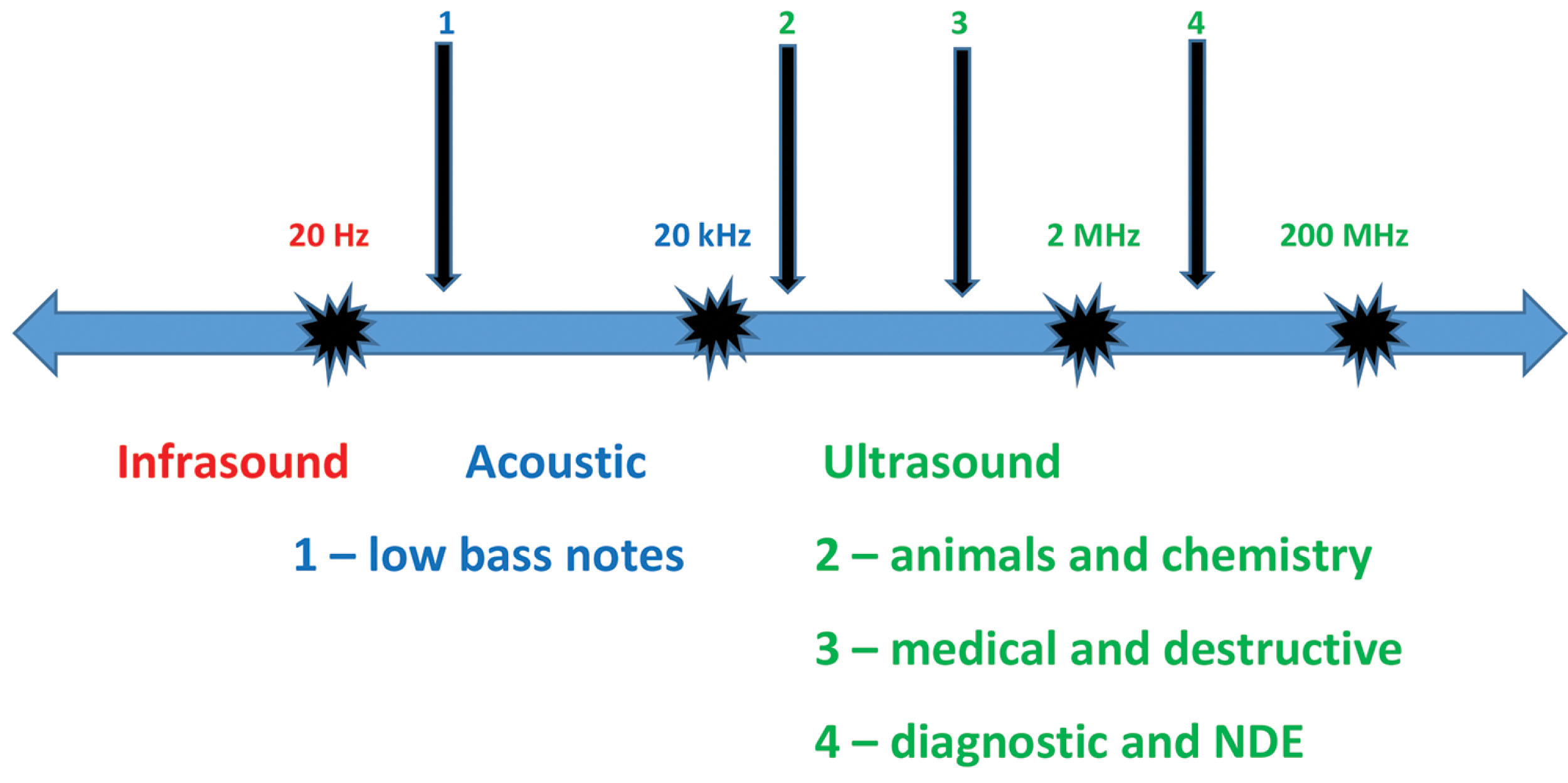
Sound is the result of mechanical energy that produces alternating compression and rarefaction of the conducting medium as it travels as a wave ( Fig. 1.9 ). (A wave is a propagation of energy that moves back and forth or vibrates at a steady rate.) Diagnostic ultrasound uses short sound pulses at frequencies of 1 to 20 million cycles /sec ( megahertz [MHz] ) that are transmitted into the body to examine soft tissue anatomic structures ( Table 1.1 ). In medical ultrasound, the piezoelectric vibrating source within the transducer is a ceramic element that vibrates in response to an electrical signal. The vibrating motion of the ceramic element in the transducer causes the particles in the surrounding tissue to vibrate. In this way the ultrasound transducer converts electrical energy into mechanical energy as the sonographic imaging is produced. As the sound beam is directed into the body by the transducer at various angles to the organs, reflection, absorption, and scatter cause the returning signal to be weaker than the initial impulse. Over a short period of time, multiple anatomic images are acquired in a real-time format.
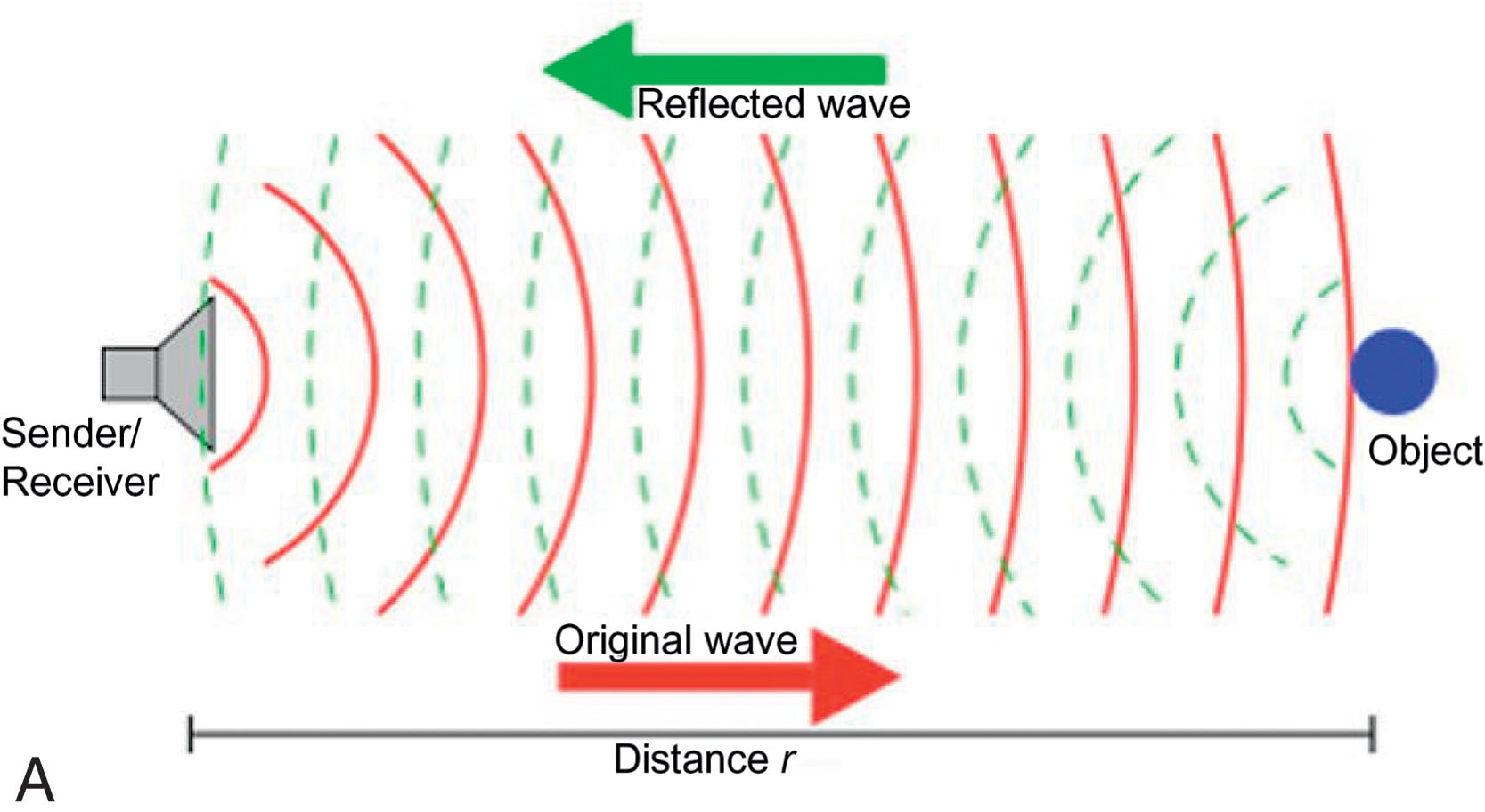
| Frequency Range | Manner of Production | Application |
|---|---|---|
| Infrasound | ||
| 0–25 Hz | Electromagnetic vibrators | Vibration analysis of structures |
| Audible | ||
| 20 Hz–20 kHz | Electromagnetic vibrators, musical instruments | Communications, signaling |
| Ultrasound | ||
| 20–100 kHz | Air whistles, electric devices | Biology, sonar |
| 100 kHz–1 MHz | Electric devices | Flaw detection, biology |
| 1–20 MHz | Electric devices | Diagnostic ultrasound |
The velocity of propagation is constant for a given tissue and is not affected by the frequency or wavelength of the pulse. In soft tissues, the assumed average propagation velocity is 1540 m/sec ( Table 1.2 ). It is the stiffness and the density of a medium that determine how fast sound waves will travel through the structure. The more closely packed the molecules, the faster is the speed of sound.
| Material | Acoustic Impedance (g/cm/sec × 10) | Velocity |
|---|---|---|
| Air | 0.0001 | 331 |
| Fat | 1.38 | 1450 |
| Water | 1.50 | 1430 |
| Blood | 1.61 | 1570 |
| Kidney | 1.62 | 1560 |
| Liver | 1.65 | 1550 |
| Muscle | 1.70 | 1580 |
| Skull | 7.80 | 4080 |
The velocity of sound differs greatly among air, bone, and soft tissue, although the velocity of sound varies by only a little from one soft tissue to another. Sound waves travel slowly through gas (air), at intermediate speed through liquids, and quickly through solids (metal). Air-filled structures, such as the lungs and stomach, or gas-filled structures, such as the bowel, impede the sound transmission, and sound is attenuated through most bony structures. Small differences among fat, blood, and organ tissues that are seen on an ultrasound image may be better delineated with higher-frequency transducers that improve resolution but lose the depth penetration.
The decibel (dB) unit is used to measure the intensity (strength), amplitude, and power of an ultrasound wave. Decibels allow the sonographer to compare the intensity or amplitude of two signals. Power refers to the rate at which energy is transmitted. Power is the rate of energy flow over the entire beam of sound and is often measured in watts (W) or milliwatts (mW). Intensity is defined as power per unit area. It is the rate of energy flow across a defined area of the beam and can be measured in watts per square meter (W/m 2 ) or milliwatts per square centimeter. Power and intensity are directly related: If you double the power, the intensity also doubles.
Sound is characterized according to its frequency ( Fig. 1.10 ). Frequency may be explained by the following analogy: If a stick were moved into and out of a pond at a steady rate, the entire surface of the water would be covered with waves radiating from the stick. If the number of vibrations made in each second were counted, the frequency of vibration could be determined. In ultrasound, frequency describes the number of oscillations per second performed by the particles of the medium in which the wave is propagating:
1 oscillation/sec = 1 cycle/sec = 1 hertz (1 Hz)
1000 oscillations/sec = 1 kilocycle/sec = 1 kilohertz (1 kHz)
1,000,000 oscillations/sec = 1 megacycle/sec = 1 megahertz (1 MHz)

The sonographer should be familiar with the units of measurement commonly used in ultrasound ( Table 1.3 ).
| Quantity | Unit | Abbreviation |
|---|---|---|
| Amplifier gain | Decibels | dB |
| Area | Meters squared | m 2 |
| Attenuation | Decibels | dB |
| Attenuation coefficient | Decibels per centimeter | dB/cm |
| Frequency | Hertz (cycles per second) | Hz |
| Intensity | Watts per square meter | W/m 2 |
| Length | Meter | m |
| Period | Microseconds | μsec |
| Power | Watts | W |
| Pressure amplitude | Pascals | Pa |
| Relative power | Decibels | dB |
| Speed | Meters per second | m/sec |
| Time | Seconds | sec |
| Volume | Meters cubed | m 3 |
Once sound pulses are transmitted into a body, they can be reflected, scattered, refracted, or absorbed. Reflection occurs whenever the pulse encounters an interface between tissues with different acoustic impedances ( Fig. 1.11 ). Acoustic impedance is the measure of a material’s resistance to the propagation of sound. The strength of the reflection depends on the difference in acoustic impedance between the tissues, as well as the size of the interface, its surface characteristics, and its orientation with respect to the transmitted sound pulse. The greater the acoustic mismatch, the greater is the backscatter or reflection ( Fig. 1.12 ). Large, smooth interfaces are called specular reflectors . If specular reflectors are aligned perpendicular to the direction of the transmitted pulse, they reflect sound directly back to the active crystal elements in the transducer and produce a strong signal. Specular reflectors that are not oriented perpendicular to the sound produce a weaker signal. Scattering refers to the redirection of sound in multiple directions. This produces a weak signal and occurs when the pulse encounters a small acoustic interface or a large interface that is rough ( Fig. 1.13 ). Refraction is a change in the direction of sound that occurs when sound encounters an interface between two tissues that transmit sound at different speeds. Because the sound frequency remains constant, the wavelength changes to accommodate differences in the speed of sound in the two tissues. The result of this change in wavelength is a redirection of the sound pulse as it passes through the interface. Absorption describes the loss of sound energy secondary to its conversion to thermal energy. This is greater in soft tissues than in fluid and greater in bone than in soft tissues. Absorption is a major cause of acoustic shadowing.
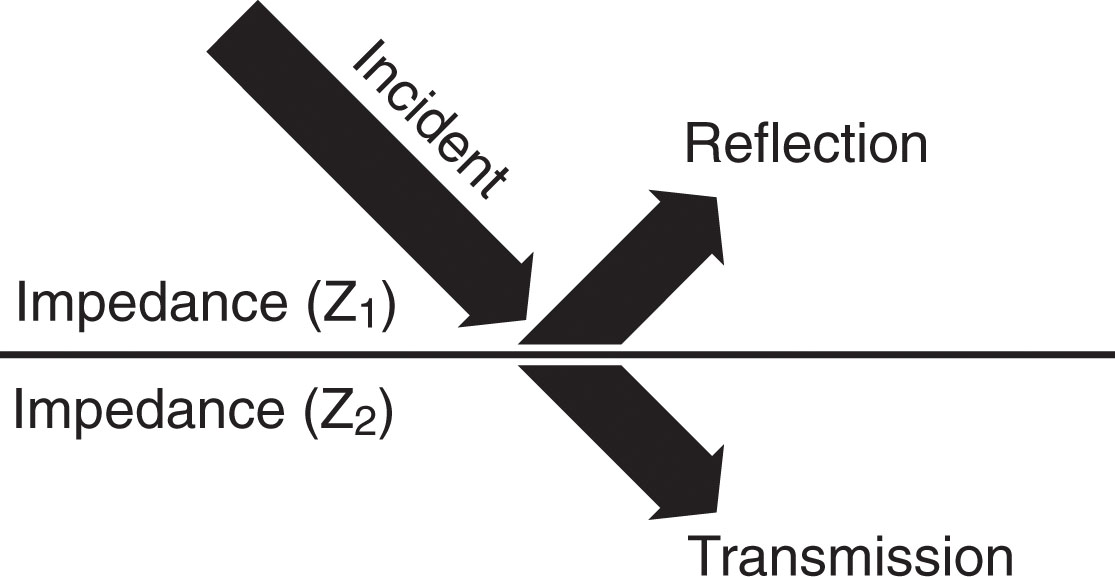
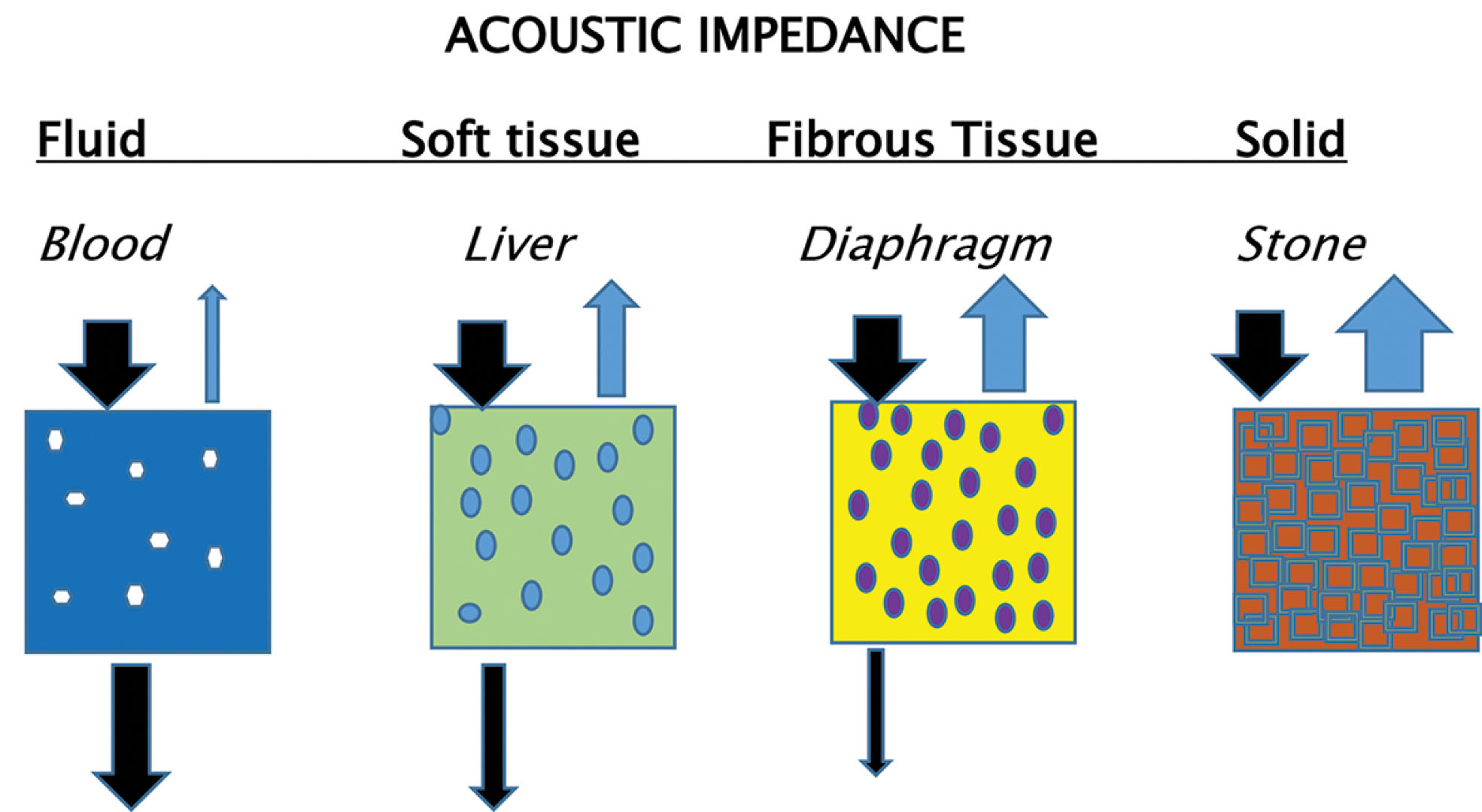

The piezoelectric effect is a method by which ultrasound is generated. An ultrasound transducer, consisting of an array of piezoelectric crystals, is used to generate and detect (or receive) ultrasound waves ( Fig. 1.14 ). An ultrasound transducer converts electrical energy to a mechanical vibration and vice versa. Because ultrasound is a mechanical wave in a longitudinal direction, it is transmitted in a straight line and it can be focused. These waves obey laws of reflection and refraction.

Pulse duration is the time that a piezoelectric element vibrates after electrical stimulation. Each pulse consists of a band of frequencies referred to as bandwidth . The center frequency produced by a transducer is the resonant frequency of the crystal element and depends on the thickness of the crystal. The echoes that return to the transducer distort the crystal elements and generate an electric pulse that is processed into an image. The higher-amplitude echoes produce a greater crystal deformation and generate a larger electronic voltage, which is displayed as a brighter pixel. These 2D images are known as B-mode , or brightness mode, images.
Resolution is the ability of an imaging process to distinguish adjacent structures in an object and is an important measure of image quality. The resolution of the ultrasound image is determined by the size and configuration of the transmitted sound pulse. Resolution is always considered in three dimensions: axial, lateral, and azimuthal (elevation). Axial resolution ( Fig. 1.15 ) refers to the ability to resolve objects within the imaging plane that are located at different depths along the direction of the sound pulse. This depends on the direction of the sound pulse, which, in turn, depends on the wavelength. Because wavelength is inversely proportional to frequency, the higher-frequency probes produce shorter pulses and better axial resolution but with less penetration. These probes are best for superficial structures such as thyroid, breast, and scrotum. Lateral resolution (see Fig. 1.15 ) refers to the ability to resolve objects within the imaging plane that are located side by side at the same depth from the transducer. Lateral resolution can be varied by adjusting the focal zone of the transducer, which is the point at which the beam is the narrowest. Azimuthal (elevation) resolution (see Fig. 1.15 ) refers to the ability to resolve objects that are the same distance from the transducer but are located perpendicular to the plane of imaging. Azimuthal resolution is also related to the thickness of the tomographic slice. Slice thickness is usually determined by the shape of the crystal elements or the characteristics of fixed acoustic lenses.
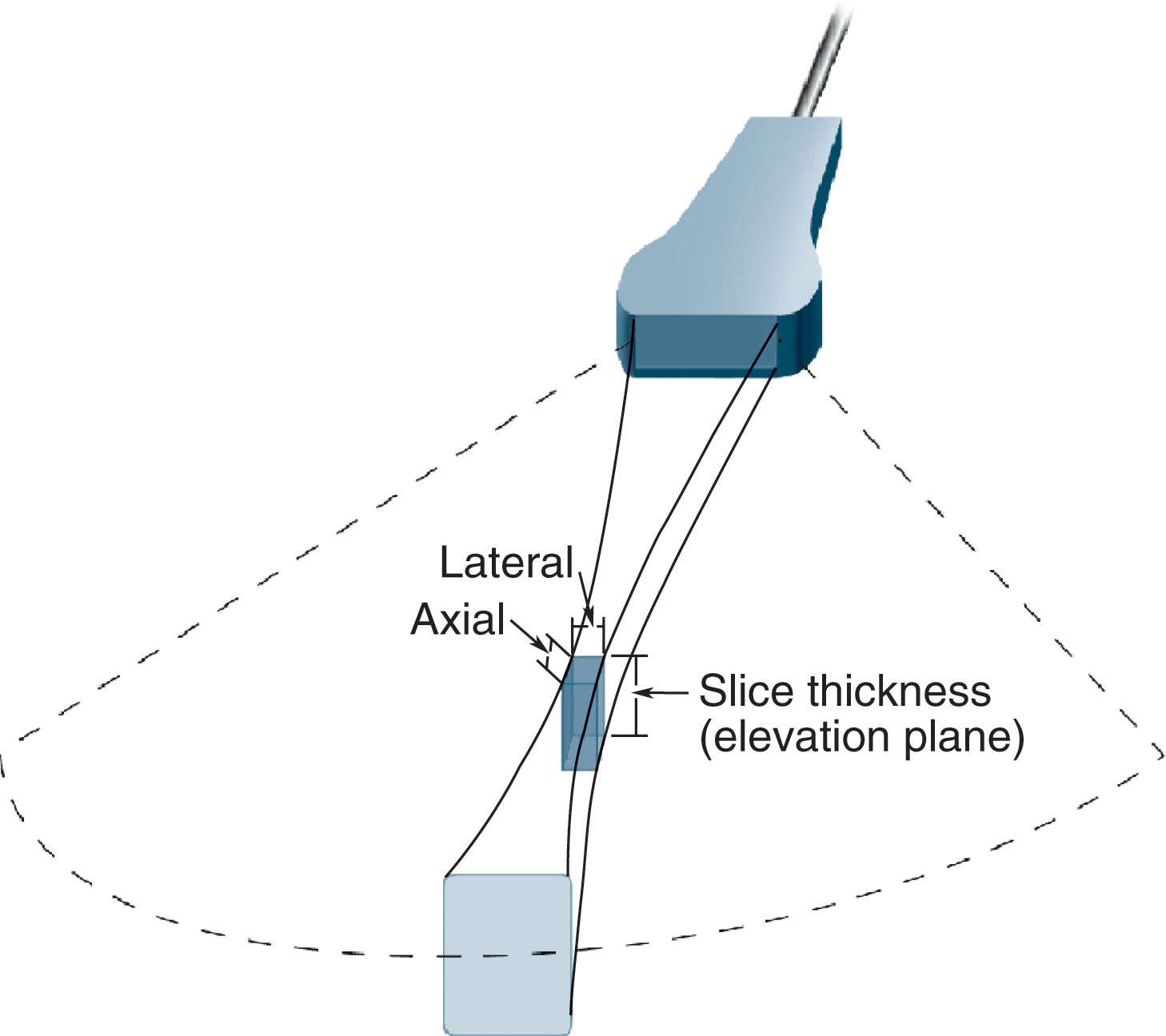
Become a Clinical Tree membership for Full access and enjoy Unlimited articles
If you are a member. Log in here